Tag: Composite bonding
Blog posts, information and advice which mention Composite bonding
Why do I have tooth sensitivity?
Many people suffer from sensitive teeth for a variety of reasons, this article highlights why you may suddenly develop sensitive teeth, what you can do about it at home, what treatments the dentist may be able to offer you and how to reduce the pain from tooth sensitivity.
What causes tooth sensitivity?
 Your teeth are made up of three primary layers:
Your teeth are made up of three primary layers:
- The nerve and pulp. This is the deepest living part of your tooth, it contains the nerve and has blood flowing through it to keep your tooth alive, it is protected by two out of protection layers.
- The dentine. This is the softer portion of your tooth, it gives the tooth it’s primary colour and its role is to support the hard yet brittle outer enamel.
- The enamel. This is the hardest substance in the human body and protects the outer portion of your tooth.
Sensitivity occurs when hot or cold substances, such as eating ice cream, get too close to the nerve, there are many reasons this could happen, including:
- Tooth wear caused by over brushing.
- Gum recession caused by over by over brushing or general ageing.
- Cracked teeth caused by trauma.
- Decay in teeth caused by poor oral hygiene.
- Tooth grinding or clenching.
Why are my teeth suddenly sensitive?
The key to understanding this is to think about how the hot or cold feeling may be getting through to the nerve. If you have had a recent trauma then perhaps the tooth is correct. If you haven’t been to the dentist for a while perhaps there is an area of tooth which is decayed.
The image below shows gum tissue recession around the gum line, possibly caused by over brushing. The enamel is thin in this area which can easily lead to teeth sensitivity.
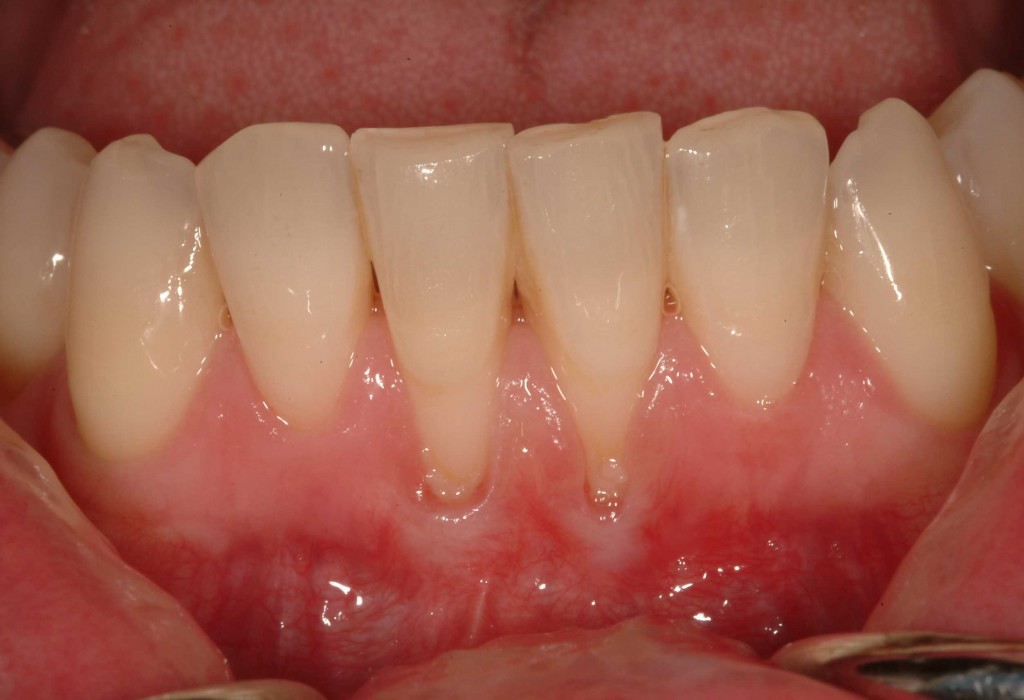
If you can’t immediately identify what the problem is then visiting a dentist or dental hygienist may be best option.
How do you stop sensitive teeth pain
If you have sensitive teeth with no obvious cause then you may find that using a protection and relief toothpaste such as Sensodyne may help.
How does Sensodyne work?
These toothpastes work because there are tiny holes, called tubules, in the dentine of your tooth. If the enamel becomes eroded away then these tubules can transmit the hot and cold through your tooth. These toothpastes work by quickly creating a barrier so that the hot and cold feeling can’t be transmitted to the nerve.
However, it’s worth noting that these types of toothpastes WILL NOT work if the sensitivity is caused by excessive enamel or dentine loss such as cavities, excessive wear or cracks caused by trauma.
How long does tooth sensitivity last?
Tooth sensitivity is usually only instantaneous when the nerve becomes exposed to hot or cold. Remove the hot or cold and the sensitivity goes away. However, the reality is that this is not practical to do on a day by day basis, we have to eat and drink after all! Unfortunately, if your teeth are sensitive they won’t get better on their own, you will either need to use a relief and protection toothpaste or visit a dentist to ascertain why your teeth are sensitive.
What does the dentist do for sensitive teeth?
The basic premise for reducing tooth sensitivity is to protect the outer surface of the tooth to prevent the hot and cold sensations been transmitted through to the nerve, or in extreme circumstances to remove the nerve itself. There are a variety of ways of treating sensitivity at the dentist, including but not limited to:
- Fluoride treatments to strengthen tooth enamel. These fluoride gels can be applied topically at the dentist or trays can be provided for use at home.
- Bonding. Composite bonding materials can be used to bonded to the outer surface of the tooth to rebuild the enamel where it has been lost. This can cover up the dentin hypersensitivity.
- Surgical gum graft (Please see the explanation video below). If the sensitivity is caused by excessive gum resorption which exposes the more sensitive root of the tooth then a gum graft to replacing some of the gum tissue may be undertaken to cover up some of this exposed area around the gum line.
- Root canal. In extreme circumstances a root canal can be used to remove the nerve of the tooth. This is not normally a preferred option and will only be undertaken in extreme circumstances.
Summary
One of the key things to focus on is brushing your teeth and maintaining good dental care throughout your life, ensuring you brush and floss regularly. Tooth sensitivity is a common problem, particularly in later life as the gum becomes more exposed and the teeth wear. Certainly, this is one of the best ways to prevent tooth sensitivity. If you are older then be aware about using a soft bristled toothbrush, watching to ensure you don’t consume too many acidic foods and drinks and be aware if you grind your teeth. Cold air can also affect sensitivity, so you may find you need to wear a scarf in cold weather.
Crowns vs Veneers vs Bonding
It’s often a dilemma knowing which to choose, crowns, veneers or bonding so we thought we would explain the differences between each in order that you can make the best decision based upon your own requirements and clinical needs.
What are the main differences between crowns, veneers and bonding?
- Cost
- Strength
- Removal of tooth structure
- Ability to change appearance of the tooth
- Frequency of replacement
Crowns vs Veneers vs Bonding Cost
The cost of crowns, veneers and bonding is determined by a couple of factors:
- The time it takes.
- The cost of materials.
- The cost of laboratory fees.
Bonding usually takes a little less time than veneers and particularly crowns, but the biggest difference is the cost of laboratory fees. Bonding is done directly onto your tooth and therefore there is no third-party laboratory required in order to manufacture the restoration, this keeps the cost down considerably.
Bonding typically starts from between £345-£445 depending upon the complexity.
Dental veneers and crowns Usually take longer than dental bonding as the dentist needs to prepare the underlying tooth structure in a very precise way in order to receive the new dental veneer and Crown. Once the dentist had prepared the underlying tooth an impression will be taken and sent to a dental laboratory, the dental laboratory then makes the veneer or crown. This extended procedure adds to the cost.
Veneers and crowns typically start from £650 depending upon the complexity.
Crowns vs Veneers vs Bonding Strength
These three restorations can be ranked in order of strength.
- Dental bonding-lowest
- Dental veneers
- Dental crowns-highest
With any type of restoration on a tooth one needs to be aware and be sensitive to the fact that what you have is not an entirely natural tooth. Dental bonding is most prone to fracture, however because the bonding is done directly onto the tooth it is the easiest to be repaired by the dentist. If veneers or crowns fracture they will need to be removed and sent back to the laboratory for repair, sometimes repairs are not possible and a full remake is required.
Crowns vs Veneers vs Bonding Removal of tooth structure
Most dentists will prefer to keep as much natural tooth structure as possible, this is generally the preferred option wherever clinically justified. Removal of tooth structure is needed in order to receive the new restoration, particularly with veneers and crowns although sometimes a small amount of tooth structure is removed for dental bonding.
The three restorations can be ranked in order of the amount of tooth structure generally required to be removed.
- Dental bonding-lowest amount of tooth structure removed
- Dental veneers
- Dental crowns-highest amount of tooth structure removed
Crowns vs Veneers vs Bonding Ability to change appearance of tooth
Depending on what change of appearance is required may define which type of restoration your dentist uses.
- Minor chips and shape defects can be corrected with dental bonding.
- More major chips and shape defects plus the colour of the tooth can be corrected with dental veneers.
- The most severe chips, shape defects, tooth rotations and tooth wear can be corrected with dental crowns.
Crowns vs Veneers vs Bonding Frequency of replacement
The frequency of replacement will usually be determined by the following:
- How quickly the materials used becomes worn or discoloured.
- How well you look after the restoration, teeth and gums.
- How careful you are when eating.
- How well do you protect your teeth during sport.
- Not having any accidents!
As you can see you will play an active role in maintaining the restoration and ensuring it lasts as long as possible.
Typical problems and reasons for replacement are as follows:
- Dental bonding
- The composite bonding material can discolour due to strong coloured foods being consumed or smoking etc
- The restoration can chip due to excessive biting forces.
- Dental veneers & crowns
- The restoration can chip due to excessive biting forces.
- The surrounding teeth change colour (either darker through age or whiter through whitening) and the dental veneer no longer matches and needs to be replaced.
- The gum margin on the tooth recedes due to age (a natural phenomenon), this can then expose the underlying tooth which often look starker. This necessitates remaking the veneer or crown in order to cover up his newly exposed underlying tooth.
Summary
As you can see, the decision about whether to have crowns, veneers or bonding is not a simple one. It involves taking into account many factors and balancing out the risk factors in order to ensure you have the very best restoration for your budget, requirements and clinical suitability. Cosmetic dentistry such as this is very often as much an art as it is a science.
Looking for an emergency dentist? Here’s what you need to know
The search term “Emergency dentist near me” gets almost 4000 searches in the local area per month, so we know that people looking for an emergency dentist and that they need information about treatments and options available.
We have broken this article on emergency dental treatments down into a few headings:
- Teeth which have come out completely.
- Loose teeth.
- Broken teeth.
- Tooth abscesses.
1. Teeth which have come out completely
What to do if the tooth comes out completely
If the tooth has come out completely you may be able to replace it so long as it is not damaged. If there are still blood vessels or nerves attached do your best to keep these intact and only hold the tooth by the crown section and not the roots.
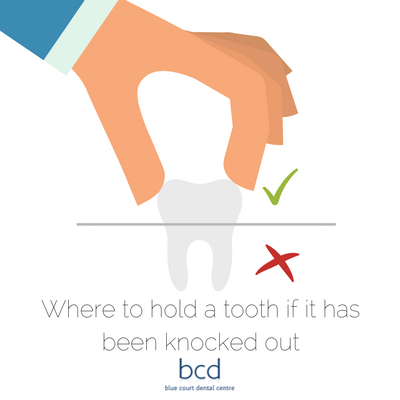
If you can, gently place the tooth back into the socket ensuring it is the right way round. Only do this if the tooth is completely clean and hasn’t been in contact with the ground.
If the tooth has been in contact with the ground place it into a clean (ideally sterile) plastic bag with some milk and take it with you to your dentist or accident and emergency at the local hospital.
If the socket is bleeding profusely then gently bite down onto a soft piece of gauze, when the bleeding subsides don’t immediately remove the gauze as this could dislodge the blood clot and the bleeding could start again. Alternatively use a cold teabag, it has been shown that the tea contains substances which can help to reduce the amount of bleeding.
Do teeth grow back in adults?
Unfortunately not. Once your baby/deciduous teeth have fallen out you only get one set of permanent teeth. The only teeth which may grow after this initial set have come through are the very last molars or wisdom teeth.
2.Loose teeth
Can a loose tooth become tight again?
If the looseness of the tooth has been caused by gum disease then yes, if the gum disease is treated and the problem resolved then the tooth can tighten up again. This shows the importance of the early treatment of gum disease and how the situation can be saved if caught early.
3.Broken teeth
Is a chipped tooth an emergency?
A chipped tooth is only an emergency if either the tooth is bleeding or the gum surrounding the tooth is bleeding and won’t stop. If the tooth has chipped and there is no pain or bleeding then this would not normally be considered a dental emergency, you should however make an appointment to see the dentist as soon as possible to rebuild the tooth if required.
Can a chipped tooth heal itself?
Amazingly, yes, a chipped tooth can heal itself but it won’t rebuild itself. If the tooth chips and the softer underlying dentine has become exposed the tooth will react to this and create what is known as secondary dentine. This secondary dentine is often much darker but is also harder and will protect the softer underlying tooth. If you want the full contour of the chipped tooth to be restored then the only way to do this is to visit your dentist who will then use dental bonding or possibly veneers or a crown.
How to fix a chipped tooth
A chipped tooth can only be fixed by your dentist. If the chip is small then they may use dental bonding to rebuild the full contour of the tooth. If the chip is significant then dental bonding may not be adequate and a full dental crown or veneer can then be used. This may require a small amount of reduction of the healthy tooth structure in some instances.
4.Tooth abscesses
Is an abscess a dental emergency?
Yes. an abscess is a buildup of pus from an infection around the tooth. It is characterised by significant swelling, redness and pain. An abscess will not go away on its own and in extreme circumstances can spread to other parts of the body and make you ill.
What helps a tooth abscess?
If you have a tooth abscess then we recommend you contact your emergency dentist as soon as possible, whilst you are waiting to see them you can reduce the pain by rinsing your mouth with warm salt water, this is particularly effective if the abscesses caused by gum infection. Saltwater can help to remove bacteria from the infected area.
We also recommend:
- Taking recommended doses of over-the-counter painkillers.
- Avoiding particularly hot or cold food and drinks as it may make the pain worse.
- Eating on the opposite side of your mouth.
- Using a softer toothbrush than you would normally and don’t floss around the affected area until it has been seen by a dentist.
Please note, these are all temporary solutions and you will need to see a dentist to get the abscessed sorted.
- Dr Dixit is the new President of British Academy of Cosmetic Dentistry - 28 May 2020
- Does Invisalign hurt? - 9 March 2020
- How Long Does Invisalign Take? - 27 February 2020
My Sweet Treats
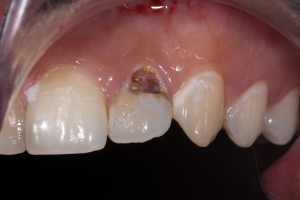
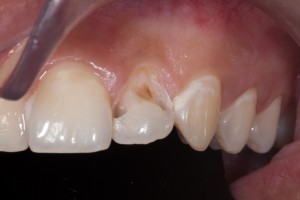
This young gentleman came to us when he started noticing something very odd about his tooth. It appeared to be changing colour. It started off as a greyish shadow, and as months went by, it became darker and more obvious. A large groove had developed and every time the patient laughed or smiled, he would raise his hands to cover his mouth (picture 1). For a very sociable young man, his confidence had started to drop.
After a consultation between the patient and Dr Dixit, it was found that the patient had a high sugar diet consisting of fizzy drinks, cakes and biscuits. The frequency of the sugary foods and the inability to clean affectively caused his tooth to decay close to the gum margin. To restore this badly decayed tooth, the decay was cleaned out (picture 2) and replaced with a composite tooth coloured filling material (picture 3) .
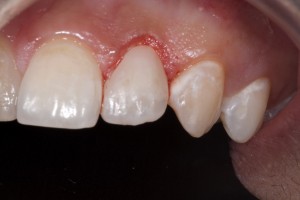
The filling material blended in with the patients existing tooth colour. The patient was very pleased with the result. His confidence had been regained and he no longer covered his mouth when he laughed. He felt very proud and happy to show off his natural looking new tooth.
Composite Bonding to change a funny shaped tooth
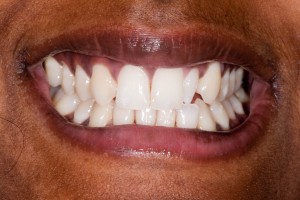
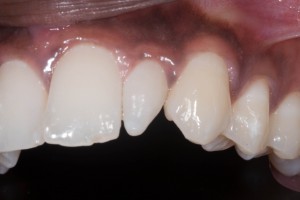
This young lady did not like the shape and appearance of her peg tooth, as it was very visible when she smiled . She was going away and wanted something done as quickly as possible.
We decided to do some composite bonding, as this was the quickest and least destructive option to achieve the desired effect.
A tooth coloured composite material was used to change the shape and appearance of her tooth and the colour was matched to make her new tooth look as natural as possible. She is now able to smile with confidence.
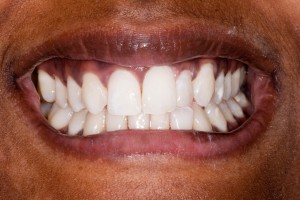

The patient was very happy with her new tooth.


